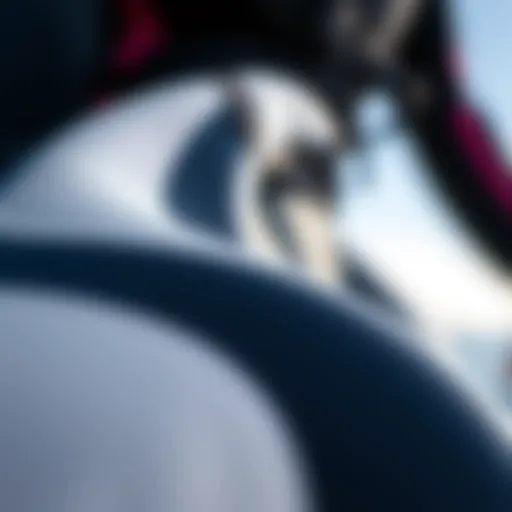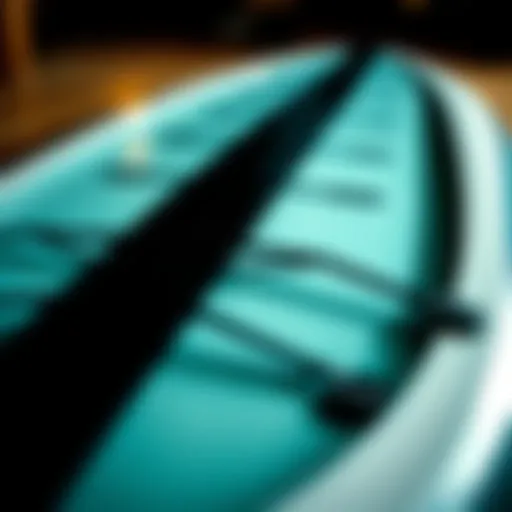Maui Satellite Weather Insights for Kiteboarding
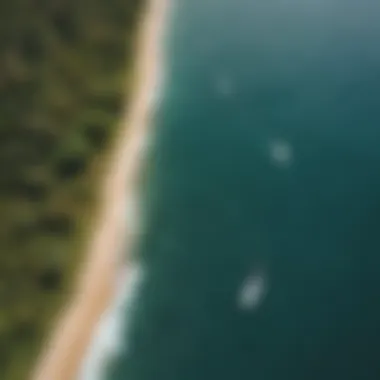

Intro
Maui is not just a slice of paradise; it’s a vibrant playground for kiteboarders, thanks to its unique weather patterns and ideal wind conditions. Understanding how satellite weather data shapes these conditions can drastically elevate a kiteboarder’s experience on the water. If you’re eager to harness the winds and waves with finesse, it's essential to comprehend the interplay between environmental elements and kiteboarding performance.
This article dives into the specific weather nuances of Maui as captured by satellite technology, which can be a game-changer for both novices and seasoned enthusiasts. Knowing when to hit the water can mean the difference between a thrilling ride and a frustrating session. From understanding wind patterns to selecting the right gear and developing essential skills, we will unpack how satellite weather data serves as more than just a forecast—it’s a compass guiding kiteboarders toward success.
We'll explore aspects like gear selection, honing your skills, and specific tips that can make your kiteboarding outings in Maui not just successful but downright enjoyable. Join us as we unveil the insights that will prepare you to catch the best waves and breeze, ensuring every kiteboarding adventure is memorable.
Overview of Maui's Climate
Maui boasts a unique and complex climate that plays a crucial role in shaping kiteboarding conditions. For those who ride the winds of this Hawaiian paradise, understanding the local climate is not just beneficial; it’s essential. The interplay of geographical factors, seasonal shifts, and microclimates creates a diverse playground for enthusiasts at all levels.
This section explores how Maui's distinctive geography influences its weather patterns, creating varied environments perfect for kiteboarding. Enthusiasts need to understand these nuances, as they directly affect wind strength, wave size, and overall safety during sessions.
Geographical Influences
Maui is not just another island; it’s a geographical tapestry woven together by volcanic mountains, valleys, and coastal features. The Haleakalā volcano, standing tall at over 10,000 feet, acts as a formidable barrier against trade winds, which helps create distinct weather patterns on its eastern and western shores.
- Wind Patterns: The northeast trade winds generally bathe the northern shores with consistent breezes, providing ideal conditions for kiteboarding. On the other hand, the leeward sides feel considerably different due to the sheltering effect of the mountains.
- Rainfall Distribution: The sharp contrast between the lush, rain-soaked windward slopes and the arid leeward beaches results in varying humidity and precipitation levels, impacting visibility and surface conditions for kiteboarding activities.
These geographical elements dictate not only the strength and angle of winds but also create varied temperatures that can significantly affect kiteboarders’ experiences.
Microclimates and Their Effects
Understanding Maui’s microclimates is like reading between the lines of its weather patterns. These localized atmospheric conditions can change within mere miles, creating various riding experiences all in one day.
- North Shore vs. South Shore: On the North Shore, stronger winds and more frequent rain might pose challenges, but they also lead to more invigorating surfing and kiteboarding opportunities. Conversely, the South Shore, known for calmer winds and sunnier weather, often attracts beginner kiteboarders.
- Temperature Variations: The temperature can swing widely, influenced by elevation and proximity to the ocean. Cooler temperatures at higher altitudes, especially in Pike's Peak region, can alter how the wind feels during a session, making proper gear selection vital.
A kiteboarder’s ability to adapt to these microclimates can often be the difference between a thrilling day on the water and a disappointing session cut short by unexpected weather changes.
For kiteboarders looking to harness the wind and waves, comprehending these microclimatic effects can enhance decision-making and foster safer, more enjoyable outings. Not only does it inform them about ideal conditions to practice, but it also highlights potential areas to avoid when weather takes a turn.
Foreword to Satellite Weather Technology
Understanding satellite weather technology is downright essential for kiteboarders in Maui. This technology not only offers insights into weather conditions but also plays a pivotal role in determining the best times to hit the waves. The interplay between human activity and nature can be unpredictable, and having reliable data can keep kiteboarders safe, informed, and ready to ride the right gusts at the right moment.
The benefits of harnessing satellite weather technology are multifaceted. Kiteboarders can make educated decisions based on a broader spectrum of data, allowing for enhanced experiences on the water. When various weather patterns are monitored and interpreted accurately, kiteboarders can sidestep sudden storms or overly light winds that might ground their plans. Consequently, the importance of staying attuned to technological advancements in weather prediction cannot be overstated for anyone passionate about this sport.
Historical Development of Satellite Weather
The evolution of satellite weather technology can be traced back to the mid-20th century. Initially, weather forecasting relied heavily on ground-based observations and rudimentary models. With the launch of the first weather satellite, TIROS-1, in 1960, the game of meteorology began to change drastically. This pioneering satellite provided a new perspective, capturing photographic images of weather patterns from space.
From the early black-and-white images, advancements led to a spectrum of technologies that allow for real-time weather monitoring. By the late 1970s, satellites could provide multispectral imagery, which helps to differentiate between various types of clouds and their characteristics. This development was a game changer for meteorologists, as it provided necessary information about temperature, moisture levels, and storm systems.
As satellite technology progressed, so did its practicality for kiteboarders. With more accurate data regarding wind speeds and directions, kiteboarding aficionados can plan outings more effectively. In a sport where every gust counts, this historical backdrop illustrates just how vital satellite weather technology has become.
Types of Satellite Imagery
Diving into the types of satellite imagery, it’s like opening a treasure chest for anyone interested in weather patterns. There are two primary categories: visible and infrared imagery. Visible imagery works by capturing sunlight reflected off clouds and the Earth's surface. This type of imagery is particularly useful during the daytime, offering clear insights into cloud formations and their movements.
Infrared imagery, on the other hand, measures thermal energy emitted by objects on Earth, allowing for weather observation even in the absence of sunlight. A cloudy night? No problem. Infrared data can still reveal the temperature differences between cloud tops and land or water surfaces, adding depth to forecasts.
The choice between these two types of imagery can depend on what you’re looking for. Kiteboarders rely heavily on wind data, which is affected by cloud coverage. Understanding how to interpret both visible and infrared images helps enthusiasts gauge the likelihood of getting the right wind conditions for their desired experience. For instance, a shift in cloud patterns visible in satellite imagery can suggest changes in wind flow, crucial knowledge for making the best out of available conditions.
"The satellite data is like having an insider's tip before the game. It can save you from a washout or land you right in the middle of the perfect conditions."
In summary, the world of satellite weather technology is rich with insights. Kiteboarders who take the time to learn about this technology can significantly enhance their experiences on the water. By leveraging historical advancements and understanding different imagery types, enthusiasts will feel more equipped and capable to tackle the ocean's challenges.
Maui Satellite Weather Data Sources
Maui’s unique climatic conditions require a nuanced understanding of satellite weather data. Knowing where to obtain reliable information is crucial for kiteboarding enthusiasts looking to catch the perfect gust. This section explores different sources from government agencies and private entities, each serving a vital role in weather prediction and analysis. When the skies open up and the winds blow just right, having dependable data can mean the difference between an exhilarating ride and a wasted trip if the forecast is off.
Government Agencies and Resources
When it comes to deciphering Maui's weather patterns, government agencies provide some of the most credible and comprehensive resources. The National Oceanic and Atmospheric Administration, or NOAA, is a standout. NOAA's satellite technology allows them to gather important data about wind speeds, temperature variations, and storm systems. They issue forecasts and alerts that can directly impact kiteboarding decisions.
Key Features of NOAA Resources:
- Accuracy: Government agencies back their data with research and professional meteorologists.
- Accessibility: Publicly available websites provide real-time updates.
- Local Insights: Some agencies offer detailed reports focused on specific regions, which is particularly useful for enthusiasts in Hawaii, where local conditions matter significantly.
Another essential source is the U.S. Geological Survey. Though generally focused on geological phenomena, they also contribute data relevant to weather, particularly as it relates to the coastal and marine environments crucial for kiteboarders.
"Up-to-date information from reliable government sources is your secret weapon against unpredictable weather!"
Private Weather Services
While government data is invaluable, private weather services can offer a tailored experience that sometimes fits kiteboarding needs even better. Companies like AccuWeather and Weather.com provide specialized forecasts that factor in local geography and seasonal changes. Many kiteboarders swear by these platforms for their detailed wind and wave forecasts.
Advantages of Private Weather Services:
- Customization: Many services allow you to set alerts for specific conditions—say, a particular wind speed that gets your adrenaline pumping.
- User-Friendly Interfaces: Typically, these sites have engaging visuals, which help in quickly interpreting cloud cover and wind patterns.
- Community Feedback: Platforms often include sections for users to share experiences, which can help gauge conditions in real-time.
Analyzing Weather Patterns in Maui
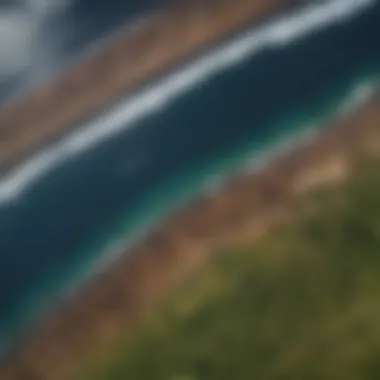

Understanding weather patterns in Maui is not just a curiosity for kiteboarding enthusiasts; it’s the very backbone of planning successful and safe outings on the water. Maui's unique climatic conditions, influenced by its geography and trade winds, create variabilities that can significantly affect kiteboarding experiences. Knowledge of these patterns helps kiteboarders adapt to changing conditions, ensuring they can enjoy their sport to the fullest while maintaining safety.
Seasonal Variations
Maui experiences distinct seasonal changes that kiteboarders should be aware of. The dry season, typically from April to October, showcases consistent trade winds that make for ideal kiteboarding conditions. Winds can clock between 15 to 25 knots during this time, providing ample power for even those who favor more advanced maneuvers.
As the wet season rolls in from November to March, wind patterns can fluctuate dramatically. This period often brings stronger storms, which can result in unpredictable gusts and sudden wind shifts. It's during this time that kiteboarders must keep their wits about them and stay vigilant when analyzing weather reports.
Key considerations during seasonal variations include:
- Wind Consistency: The summer months generally provide more stable wind conditions. Keep this in mind when planning trips.
- Temperature Changes: While air temperatures hover in the comfortable range year-round, humidity and ocean temperatures can dip in the winter, affecting your comfort level on the water.
- Precipitation: Understanding rainfall patterns can inform kiteboarders about potential hazards, like rougher water conditions after a heavy rain.
Impact of Trade Winds
Trade winds play a gigantic role in defining Maui’s weather, acting as the driving force behind kiteboarding conditions. These winds generally blow from the northeast and can vary in strength depending on the season and local weather systems. For kiteboarders, familiarity with these winds is crucial, as their reliability means they can often predict a great day on the water.
The trade winds usually kick up between 10 AM and 4 PM, affording nearly an entire day filled with chances for thrill seekers. However, wind strength is not just about the overall speed; it entails understanding gusts and lulls. For example, some spots might be windier than others due to geographic features like cliffs or valleys.
Kiteboarders should take note of the following wind-related factors:
- Gustiness: Periods of rapid speed changes can affect control, especially for less experienced kiteboarders.
- Local Topography: Natural features can significantly alter wind conditions. Areas like Kanaha Beach often see stronger winds because of its exposure to open ocean conditions.
- Optimal Angles: The angle of the wind can dictate which type of kite to use and how to position oneself on the water for maximum performance.
"Understanding how trade winds influence the kiteboarding experience is akin to having a compass – it points you toward safety and enjoyment, navigating the unpredictable waters of Maui."
By thoroughly analyzing these weather patterns, kiteboarding enthusiasts can better prepare themselves for exhilarating sessions on the water while minimizing risks associated with unpredictable weather conditions.
Importance of Wind Data for Kiteboarding
Understanding wind data is crucial for kiteboarding in Maui. The island is known for its diverse wind conditions, which can change faster than you can say "kite!" As kiteboarders, we rely heavily on accurate wind information to have a safe and enjoyable experience on the water. Not only does wind determine whether you can hit the waves, but it also impacts the type of gear you use.
With the right wind data at your disposal, kiteboarders can make informed decisions. This can mean the difference between a thrilling session and a frustrating day spent on the beach. Here’s a closer look at the specific elements and benefits involved in understanding wind data.
Benefits of Accurate Wind Data
- Predicting Conditions: Knowing wind patterns allows kiteboarders to predict ideal riding conditions. Experienced riders can tell when the wind will pick up or die down based on historical data, which enhances their overall performance.
- Safety: Understanding wind can help prevent accidents. Kiteboarding in gusty conditions can be dangerous. Proper wind info can steer experienced riders away from hazardous environments.
- Optimal Gear Selection: Different wind speeds require different equipment. For instance, lighter winds may call for larger kites, while stronger winds necessitate smaller ones.
- Enhanced Performance: By familiarizing themselves with local wind patterns, kiteboarders can tweak their skills to match conditions. This can lead to not just improved performance but also a deeper connection and appreciation for the sport.
"Wind data is not just numbers; it's a kiteboarder's secret weapon for enjoying the perfect session!"
These benefits are invaluable for not only beginners but also seasoned kiteboarding enthusiasts looking to maximize their time on Maui's beautiful waters.
Wind Patterns and Their Predictability
Maui’s wind patterns are influenced by geographical features and seasonal changes. Understanding how these patterns work can be likened to reading a book - once you know the language, it becomes much easier to interpret.
- Trade Winds: The island experiences consistent trade winds, especially during the summer months, making it a hotspot for kiteboarding. Typically, these winds blow from the northeast. This creates ideal conditions that many kiteboarders look forward to each year.
- Gusts and Lulls: However, kiteboarders should be wary of gusts and lulls throughout the day. These can happen unexpectedly and can turn a kiteboarding adventure upside down in a heartbeat. Tracking these shifts in wind is essential for previewing how the day might go.
- Microclimates: Remember, Maui isn’t a one-size-fits-all. Different locations on the island can have completely different wind conditions due to the unique microclimates. One area may be perfectly windy, while a short drive could lead you to a calm spot.
Understanding Wind Forecasting Models
When it comes to wind forecasting, various models provide kiteboarders with crucial insights. Surfing the web for the right information can feel like searching for a needle in a haystack at times. Still, familiarizing yourself with these forecasting tools can pay off in dividends.
- Numerical Weather Prediction (NWP) Models: These models use mathematical calculations to predict wind behavior based on numerous atmospheric factors, such as pressure and temperature. Familiarizing oneself with sites providing NWP can feel like unlocking a treasure chest of information.
- Local Observations: Alongside models, local real-time observations from weather stations give kiteboarders insight into what's currently happening. These can often reveal discrepancies between forecasted and actual conditions, so they act as a reliable check on predictions.
- Apps and Tools: With technology at our fingertips, there are several apps kiteboarders can utilize. Websites like Windy or MagicSeaweed provide detailed information on wind conditions at various locations around Maui.
By actively engaging with these different forecasting models, kiteboarders can develop a far sharper intuition about when to hit the water and when to sit it out. As they say, knowledge is power, and this holds particularly true for those eager to harness the winds for an exhilarating ride.
Interpreting Satellite Weather Imagery
Interpreting satellite weather imagery is an essential skill for kiteboarding enthusiasts in Maui. It provides real-time data about weather conditions that directly impact kiteboarding activities. Understanding how to read these images can make the difference between a thrilling day on the water and facing unfavorable conditions. Kiteboarders can glean valuable insights from cloud formations, wind patterns, and other meteorological events to optimize their riding experience.
Reading Cloud Patterns
Cloud patterns play a significant role in determining the weather, and this is where kiteboarders can really gain an edge. By observing the types and formations of clouds through satellite images, you can forecast incoming weather conditions.
- Cumulus Clouds: Typically indicate fair weather, making them good indicators for kiteboarding.
- Stratus Clouds: These often signal overcast skies and can bring light rain. It's wise to proceed with caution when seeing this pattern.
- Cumulonimbus: A red flag for any kiteboarder. This type of cloud signals thunderstorms and severe weather, so it's best to steer clear.
Being familiar with these cloud types allows kiteboarders to anticipate changes in wind and weather conditions. As the saying goes, a stitch in time saves nine; in this case, understanding cloud patterns can lead to safer kiteboarding adventures.
Utilizing Infrared vs. Visible Imagery
When it comes to satellite imagery, you have two primary types to work with: infrared and visible. Each serves a distinct purpose and can be a powerful tool for kiteboarders.
- Visible Imagery: Shows the sunlight reflecting off clouds and land features, allowing you to visualize cloud cover and areas of sunlight. This can help identify whether the conditions are clear or if there are potential weather disturbances nearby.
- Infrared Imagery: Unlike visible imagery, infrared shows temperature differences. This is particularly helpful in identifying clouds; colder cloud tops can indicate higher and thicker clouds, which could lead to precipitation. Knowing the temperature gradients can help you predict sudden changes in conditions.
Integrating both types of imagery into your planning can vastly improve your kiteboarding experience. For instance, if infrared imagery shows a drop in temperature while visible imagery indicates a cloud cover, taking a rain check is probably a good idea.
"Knowledge is power; for kiteboarders, understanding satellite imagery can mean the difference between soaring above the waves or remaining grounded due to bad weather."
Predictions and Forecasting Accuracy
In the realm of kiteboarding, understanding predictions and forecasting accuracy is paramount. For kiteboarders, having reliable weather predictions at their fingertips can be the difference between a thrilling ride and an unfortunate mishap. The intricacies of weather forecasting play a critical role in planning out kiteboarding excursions, ensuring optimal wind and weather conditions.
Understanding Forecast Models
Forecast models serve as the backbone of weather prediction. These complex systems compile vast amounts of data collected from satellites, buoys, and weather stations. The models utilize algorithms to simulate and predict atmospheric conditions based on the existing data. For kiteboarders, familiarity with these models provides valuable insight.
There are different types of forecast models to keep in mind:
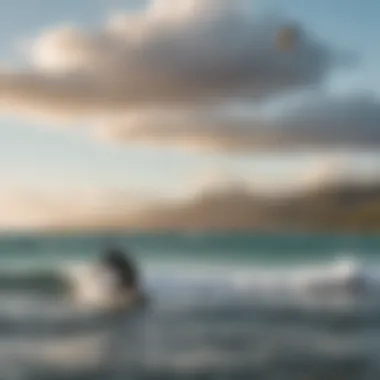

- Numerical Weather Prediction (NWP): This involves creating mathematical equations that describe the atmosphere's behavior. NWP models are often the most accurate and are utilized extensively for short-term forecasting.
- Statistical Models: By analyzing past weather patterns, these models produce forecasts based on historical data. While not as precise as NWP, they can still be quite helpful, especially in identifying trends.
Kiteboarders should also look into specific wind forecasting models. Understanding how these models generate forecasts can aid in making informed decisions. For instance, checking multiple sources can clarify discrepancies and lead to a better prediction of conditions.
Limitations of Satellite Data
While satellite data has revolutionized weather forecasting, it does have limitations. A common misperception is that satellite images provide clarity and precision. However, this isn’t always the case. Localized anomalies, like terrain and urban development, can skew data. Satellite images often reflect broader conditions rather than pinpoint specifics that can influence kiteboarding.
Some significant limitations include:
- Resolution of Data: In some cases, the granularity of satellite imagery may not be fine enough to accurately depict coastal or localized wind conditions that kiteboarders depend on.
- Data Timeliness: Satellite updates can lag, meaning weather changes might go unrecorded at critical moments. For kiteboarders, this can lead to unexpected conditions.
- Cloud Coverage: Cloudy conditions can obstruct satellite views, making it challenging to detect weather systems accurately.
Understanding these limitations is crucial for kiteboarders. A consistent practice of corroborating satellite data with on-ground resources can significantly enhance forecast accuracy and safety.
The key takeaway for kiteboarding enthusiasts is that while satellite data is invaluable, it shouldn't stand alone. Cross-referencing with local insights and conditions is essential for a safe and exhilarating kiteboarding experience.
In summary, grasping how predictions are made and the challenges that satellite data encounters is vital for every kiteboarding enthusiast. Knowledgeable choices based on precise forecasts can help create memories on the water, rather than regrets.
Integrating Satellite Weather Data with Kiteboarding Practices
Maui offers incredible conditions for kiteboarding, but enthusiasts must be well-equipped to adapt to the frequently shifting weather patterns. Here, integrating satellite weather data into kiteboarding practices becomes essential. Through satellite technology, kiteboarders gain insights into wind conditions, cloud cover, and other environmental factors that influence their experience on the water. This understanding isn't just a convenience; it’s a necessity for maximizing fun while minimizing risks.
Best Practices for Kiteboarders
To harness the benefits of satellite data, kiteboarders should adopt several best practices:
- Daily Weather Check: Before hitting the water, check recent satellite imagery for cloud patterns and wind direction. Online platforms provide real-time updates on changing conditions.
- Utilizing Wind Forecast Models: Leverage wind forecast models offered by specialized websites. Look for updates that highlight shifts in wind strength anticipated throughout the day.
- Documenting Conditions: Keep a personal log of conditions experienced during sessions. Use this data, mixed with satellite weather information, to recognize patterns over time.
- Connecting with Local Resources: Engage with local kiteboarding communities and forums such as reddit.com to discuss recent weather phenomena and get firsthand accounts from other enthusiasts.
In Maui, understanding the microclimates specific to various kiteboarding spots is just as important as understanding global weather patterns.
Safety Protocols Based on Weather Forecasts
Safety protocols tailored around weather forecasts can make all the difference. When kiteboarding in Maui, consider the following:
- Heed Warnings and Advisories: Pay attention to any advisories that may arise from official meteorological services. This information can often be accessed from government resources and apps providing real-time satellite weather data.
- Personal Safety Gear: Always wear a life jacket and make sure your kiteboarding equipment is in good shape. Periodically review the state of the ocean currents and tidal influences via satellite data.
- Communicate Plans with Others: Inform friends or family about your intended kiteboarding location and forecasted conditions. It’s smart to have a buddy system where others keep an eye on your activity when conditions are less predictable.
- Adjust Timing Based on Conditions: If forecasts indicate an approaching storm or unstable weather, it’s prudent to delay your session. The winds can shift dramatically, turning a fine day into a hazardous venture.
Combining satellite weather insights with these practices not only enriches the kiteboarding experience but also significantly enhances safety. Kiteboarding in Maui can be an exhilarating adventure, but being prepared for the unpredictable nature of its weather is what separates the casual rider from the experienced kiteboarder.
Notable Kiteboarding Locations in Maui
When it comes to kiteboarding, choosing the right spot can make or break your experience. Maui is a treasure trove of ideal locations that cater to both seasoned pros and newcomers alike. Each spot offers unique winds, waves, and conditions, leading to differing levels of excitement and challenge. Understanding these locations is vital, as each provides insights into how local weather patterns can influence kiteboarding conditions.
Kite Beach: A Popular Destination
Kite Beach stands proudly as one of the hottest kiteboarding spots in Maui. Located on the northern shore, just outside of Kalama Park, it’s often packed with kiteboarders, instructors, and enthusiasts eager to catch the perfect wind. The scenery here is simply breathtaking, with panoramic views of the ocean and the iconic Maui coastline.
One of the biggest draws of Kite Beach is its reliable trade winds which blow consistently, generally ranging from 15 to 30 knots. Such wind speeds are perfect for kiteboarding; they allow experienced riders to push their limits while providing beginners with the ideal conditions to learn the ropes. However, it’s crucial to keep an eye on the weather updates, as shifting weather patterns can lead to sudden changes in conditions.
Kite Beach also features several amenities, including ample parking, restrooms, and rental services for gear. Many experienced riders congregate here to share tips and techniques. A quick chat by the shore might just get you some valuable insights on the best kites to use or which maneuvers to focus on while riding.
Other Local Spots Worth Visiting
While Kite Beach is certainly a highlight, Maui hosts several other kiteboarding spots that kite enthusiasts should consider:
- Kanaha Beach Park
Located on the northern shore, Kanaha Beach Park is famous for its spacious sandy areas and shallow waters. This makes it an excellent place for newcomers to get comfortable with their kites. The park is also favored for its wider range of conditions due to the various wind directions. - Lahaina Harbor
This spot provides a different experience with slightly calmer waters, perfect for those who are still getting their bearings. It's also an ideal launching point for those interested in a more relaxed trip. Riders can enjoy stunning views while sipping on a refreshing drink after their session. - Spreckelsville
Often referred to simply as Sprecks, this location is famed for its powerful waves and advanced conditions. It’s not for the faint-hearted or inexperienced but offers exhilarating rides for those who can handle the might of mother nature.
"Every kiteboarder’s adventure on Maui starts with where they choose to ride. Knowing the best locations makes all the difference."
To optimize your kiteboarding experience in Maui, familiarizing yourself with these spots is essential. Each location has its own character, influenced by local weather patterns and wind conditions. As a kiteboarder ventures through these varied waters, the importance of weather technology becomes even more apparent.
Environmental Considerations
When diving into the world of kiteboarding, particularly in a locale as beautiful and unique as Maui, environmental considerations become paramount. This section sheds light on how kiteboarding practices can influence local ecosystems while also offering guidelines for enthusiasts to engage in this thrilling sport sustainably.
Impact of Kiteboarding on Local Ecosystems
Kiteboarding has undoubtedly carved a niche for itself, drawing enthusiasts from all over. However, with great fun comes great responsibility. The impact of kiteboarding on local ecosystems is a multifaceted issue, engaging both the natural environment and the practitioners of the sport.
The presence of kiteboarders can disrupt marine life, particularly the delicate coral reefs and other sea creatures. For instance, when kites crash into the water or are launched improperly, they can create disturbances that might stress local wildlife. Additionally, if kiteboarders venture too close to nesting sites or breeding grounds, the noise and activity could be detrimental to these species.
Here are some important aspects to consider:
- Wildlife Interaction: Interacting with wildlife, whether intentionally or accidentally, can cause stress to marine animals. Avoid areas known for nesting (like seabird colonies or turtle breeding sites).
- Coral Damage: Kiteboards have the potential to damage fragile coral formations. It's essential to be aware of where you’re riding to steer clear of such areas.
- Pollution: Proper waste disposal is a must. Something as simple as forgetting to pick up small pieces of plastic can have harmful effects on marine conditions.
Environmental impact is crucial. Understanding how kiteboarding can alter these ecosystems allows kiteboarders to appreciate and protect their environment, ensuring that these stunning locations remain for future generations.
Promoting Sustainability in Kiteboarding
Sustainability is no longer just a buzzword; it’s an essential practice in the kiteboarding community. As kiteboarding grows in popularity, being mindful of sustainable practices can protect both the stunning Maui environment and enhance the kitesurfing experience.
To engage in kiteboarding responsibly, here are some practices to keep in mind:
- Eco-friendly Gear: Look out for brands that focus on sustainability. Many companies are integrating eco-friendly materials into their products. Opt for gear made from recycled plastics or sustainable materials.
- Respect Local Regulations: Many areas have specific rules regarding water sports to minimize environmental impact. Familiarizing oneself with these regulations is a responsible and beneficial practice.
- Community Involvement: Get involved with local environmental initiatives and beach clean-up drives. Building a sense of community around kiteboarding can foster a collective responsibility towards the environment.
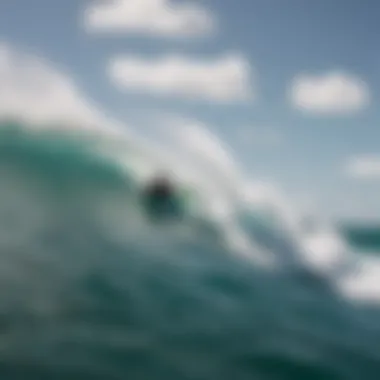

The future of kiteboarding depends on how responsibly practitioners engage with their surroundings.
By incorporating these sustainable practices, kiteboarders not only nurture local ecosystems but also contribute to the longevity of their beloved sport. It’s about striking a balance—enjoying the wind and waves while being good stewards of nature.
Community Engagement and Resources
Community engagement plays a pivotal role in creating a supportive and informed atmosphere for kiteboarders in Maui. It’s not just about riding the waves but about connecting with fellow enthusiasts, sharing knowledge, and enhancing the overall kiteboarding experience. This section explores how resources and community ties can profoundly affect newcomers and seasoned kiteboarders alike.
Connecting with Local Kiteboarding Associations
Links to local kiteboarding associations are invaluable for both newbies and veterans seeking to hone their skills in Maui’s dynamic fly zones. These organizations often serve as hubs where kiteboarders can find information about local regulations, weather updates, and upcoming events. Establishing connections with such associations can provide the following benefits:
- Networking Opportunities: Engaging with local kiteboarding groups opens doors to meet fellow riders, instructors, and even potential mentors. It’s a way to form bonds that can lead to shared riding experiences.
- Skill Improvement: Many associations hold workshops or training sessions aimed at improving maneuvers and safety practices. For example, workshops hosted by the Maui Kiteboarding Association allow participants to improve their techniques under careful guidance from experts.
- Access to Local Knowledge: These groups can provide insights into hidden spots or safer areas to kiteboard, which can make a significant difference, especially for those who may not be familiar with the bay.
Joining a local association often includes being a part of their community events, which can range from kiteboarding competitions to beach clean-ups, fostering camaraderie and responsibility.
Sharing Experiences and Data
The kiteboarding community gains immensely from sharing first-hand experiences and data related to weather conditions, equipment performance, and local regulations. This kind of knowledge exchange can take place through various channels:
- Online Forums and Social Media: Platforms like Reddit have dedicated threads for kiteboarders in Maui, where users can discuss their experiences and post real-time updates on conditions. Groups on Facebook also facilitate lively discussions that keep members informed.
- Meet-Ups and Events: In-person gatherings allow kiteboarders to discuss their latest rides, while also exchanging tips and safety protocols. Initial meet-ups can lead to friendships and partnerships on the water during kiteboarding sessions.
- Data-Driven Discussions: Participants can share specific satellite weather data that highlights changes in wind patterns or wave conditions. These conversations can help everyone gauge the best days for riding.
In summary, engaging with community associations and actively sharing experiences not only enriches personal practice but also cultivates an informed kiteboarding culture. Kiteboarders who tap into these resources can enhance their safety, skill levels, and enjoyment — all while contributing to the preservation and growth of this vibrant sport.
Advancements in Weather Technology
The evolution of weather technology has had a profound impact on how kiteboarders approach their sport in Maui. The availability of real-time weather information allows enthusiasts to make informed decisions about when and where to hit the water. With advancements in satellite technology, kiteboarders now have tools at their disposal that enhance both safety and performance. Access to accurate wind forecasts, precipitation patterns, and wave heights can transform a day of kiteboarding from potentially disastrous into a thrilling success.
Emerging Tools for Kiteboarders
The emergence of various tools tailored for kiteboarders has seen a shift in the way they interact with weather data. Mobile applications like Windy and KiteSurfing Live provide up-to-date information on wind speeds, gust predictions, and ocean conditions. These apps allow kiteboarders to check weather conditions from anywhere, ensuring that they can plan their outings effectively.
Some important aspects of these emerging tools include:
- Real-time Updates: Instant notifications about changing weather conditions can help kiteboarders avoid risky situations.
- User-Friendly Interfaces: Many apps are designed with an intuitive layout, making it easy for beginners to understand vital information.
- Community Features: Some platforms have social integration, allowing users to share experiences and insights, fostering a supportive kiteboarding community.
Because of these advancements, kiteboarders often find it easier to predict suitable conditions, tailoring their plans based on accumulated data. Coupled with local knowledge, these tools enhance overall kiteboarding experiences in Maui's unique environment.
Future of Weather Predictions for Sports
As we look ahead, the future of weather predictions for sports like kiteboarding promises even more accuracy and reliability. Developing technologies, such as artificial intelligence and machine learning, are set to advance predictive meteorology profoundly. These innovations will not only model upcoming weather conditions but adapt based on real-world data inputs.
Here are a few thoughts on what might be in store:
- Increased Precision in Forecasting: AI algorithms could drastically enhance the precision of wind and weather forecasts, potentially minimizing the margin of error.
- Customization Options: Weather apps may offer personalized forecasts based on individual kiteboarding habits and preferences, helping users to select the best times for outings.
- Integration with Wearable Technology: Future advancements may also see weather predictions integrated into wearables, like smartwatches or fitness trackers, providing real-time updates while on the water.
These emerging trends not only improve kiteboarding preparation but also ensure that kiteboarders are equipped to tackle Maui's dynamic weather with confidence.
Building upon these advancements creates a safety net for enthusiasts and instructors alike, making the sport more accessible regardless of skill level.
The gradual shift toward increasingly sophisticated prediction technology confirms that kiteboarding in Maui will evolve, harnessing data to maximize enjoyment and safety. As these tools become commonplace, one can expect a richer, more informed kiteboarding culture to flourish.
Personal Experiences of Kiteboarders
Personal experiences of kiteboarders are crucial for understanding the practical implications of satellite weather data in Maui. Real-world stories provide insights that numbers and forecasts alone cannot convey. These narratives share the reality of kiteboarding conditions, allowing other enthusiasts to learn from their triumphs and setbacks. By focusing on the personal journeys and encounters of kiteboarders, the article bridges the gap between theoretical weather data and actual kiteboarding experiences. Such information extends beyond just data; it encompasses the thrill, challenges, and adaptability of kiteboarders, ultimately enriching their experience.
Noteworthy Anecdotes
The ocean has its way of teaching lessons, and kiteboarders often have tales to tell. One local kiteboarder, Sarah, recounts a day when the wind suddenly shifted. During her session at Kite Beach, she was catching the perfect gusts, soaring over the water. But, just as she was landing a trick, a gust from a different direction hit her. "I went from flying high to a quick splashdown," she laughs now, but it also made her emphasize the importance of checking forecasts multiple times before heading out. Anecdotes like Sarah’s demonstrate not only the unpredictability of wind patterns but also the necessity for kiteboarders to remain vigilant and aligned with real-time satellite data.
Another memorable experience involves Mark, who had an eye for weather patterns. He learned to trust his instincts after a day of strong winds accompanying dark clouds on the horizon. “I was already out riding, but I noticed the clouds brewing. I took a break and checked satellite imagery on my phone,” Mark explained. It turned out the storm passed nearby, and he was able to avoid rough conditions. Such stories underline the relevance of being able to interpret satellite weather data effectively, combining instinct with technology.
Best Practices Based on Real-life Scenarios
Learning from the experiences of others provides kiteboarders with valuable strategies to navigate Maui's unique weather conditions. Here are some best practices derived from the collective experiences of seasoned riders:
- Prioritize Real-time Data: Always consult up-to-the-minute satellite images before heading out to the water. Websites and apps that provide direct satellite feeds can be game-changers.
- Develop Local Insight: Spend time observing weather patterns in Maui over different seasons. Kiteboarders like Emily suggest keeping a personal log of daily wind conditions to find trends.
- Stay Connected with the Community: Joining local kiteboarding forums or groups, such as those on Facebook or Reddit, can offer immediate insights from fellow enthusiasts who may share vital information about current conditions.
- Embrace Flexibility: Be ready to adjust plans based on real-time feedback. Kiteboarding is as much about adaptability as it is skill, as many seasoned riders have learned from firsthand experiences.
"The ocean is always teaching us, whether we’re ready or not. The key is to be aware and flexible to changes in the wind and weather." - A Maui Kiteboarding Community Member
These grounded practices will assist new and experienced kiteboarders alike as they interpret weather data in real-world contexts, ensuring safer and enjoyable sessions on the water.
The End
As we draw the curtain on our exploration of Maui's satellite weather impacts on kiteboarding, it becomes glaringly evident how intertwined these topics are. The benefits of understanding satellite data cannot be overstated; not only does it empower kiteboarders with real-time insights, but it also fosters a proactive approach to this thrilling sport.
Recapping the Importance of Satellite Weather
Satellite weather data serves as a sophisticated lens into the atmospheric conditions over Maui. For kiteboarders, this information is nothing short of essential. By recognizing wind patterns, gauging potential storm activity, and decoding temperature variations, enthusiasts can make smarter, safer choices about when and where to kiteboard. Moreover, a keen understanding of satellite imagery can reveal potential microclimates that may influence weather conditions locally, sometimes within just a few miles.
- Understanding Wind Trends: Kiteboarders gain a distinct advantage by monitoring how winds behave at different times of year.
- Avoiding Natural Hazards: Being aware of sudden weather changes can reduce the risks associated with kiteboarding in turbulent conditions.
> By utilizing satellite data, kiteboarders can boost their performance and safety, ensuring a more enjoyable experience on the water.
Encouraging Informed Kiteboarding Decisions
Making informed decisions in kiteboarding is not just about choosing the right gear; it's fundamentally tied to understanding the environment. Thus, kiteboarders must leverage the satellite weather resources available to them. Here are some recommended strategies:
- Utilize Weather Apps: Many apps harness satellite data to provide localized forecasts specific to kiteboarding spots. Don't just dive into the water; check these sources first.
- Connect with Other Enthusiasts: Online communities, like those found on Reddit or Facebook, can offer real-time reports from local kiteboarders who might provide invaluable on-the-spot assessments of conditions.
- Stay Updated on Seasonal Changes: Kiteboarding conditions can vary immensely with the seasons. Engage with resources detailing these shifts to plan your outings more effectively.
- Analyze Historical Data: Consider delving into historical satellite data. This will help you understand long-term trends that can vastly improve your kiteboarding success rate.
By integrating these practices, kiteboarders can harness the potential of satellite weather data to enhance their overall experience. Making educated choices goes a long way towards both safety and enjoyment, ensuring that you can focus more on riding the waves and less on worrying about unpredictable weather.









